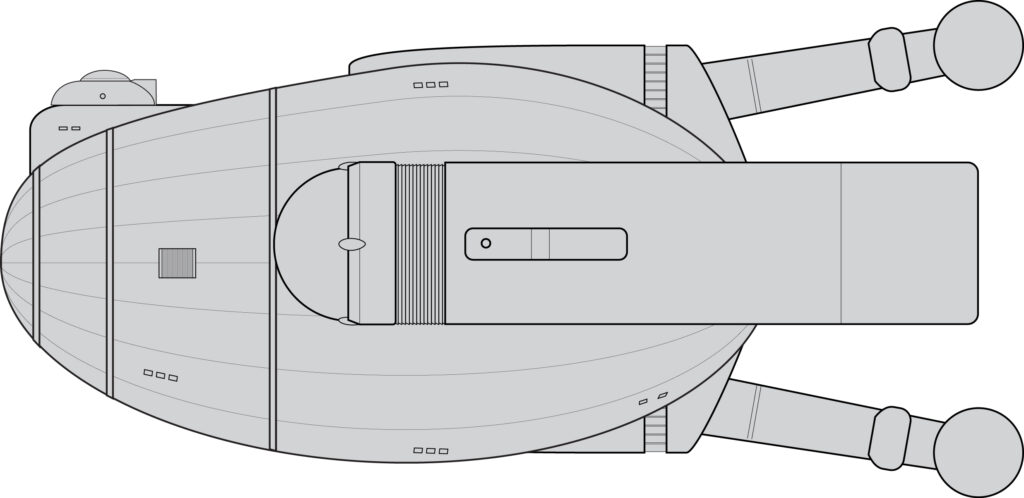updated from Star Trek: Space Flight Chronology by Stan and Fred Goldstein, with additional material from The Four Years War Sourcebook. Original text by Lee Wood.
NOTES:
The Chariot class transport was first proposed during the darkest days of the Four Years War. Starfleet proposed a small, cheap transport designed to pour its heart out in speed to carry moderate cargo loads to the embattled front. The vessel would have a small crew, a far cry from the large crew requirements of the Ptolemy and Keppler classes. Essentially two warp engines attached to a command pod, the transport would be massed produced to flood the beleaguered Federation forces with supplies.
The Chariot class was finally commissioned In 2255, rather late in the war. By the time the design was approved and funds allocated for its construction, the war had stabilized and it was clear that the Federation had strategically outmatched the Klingons. Work orders commenced, however, due to the flexibility of the design.
The Chariot was designed to be a fast and maneuverable transport. Loaded, it could maintain a speed of Warp 6, with an emergency speed of Warp 7. Carrying Its cargo in outboard cargo pods, the Chariot had orders to jettison its cargo and destroy it via remote detonation If it came under attack. This rather radical move for Starfleet was a matter of the times: during the first half of the war, it was easier to replace cargo than a transport ship. Freed of its cargo, the Chariot could achieve Warp 8 and outrun most all opposition.
Early in 2256, three Chariot transports ran the gambit to “Malta Station•, the border outpost which had been under siege by the Klingons since the outbreak of hostilities. The Klingons detected the transports, but were unable to engage them in time due to the high speed of the Chariots. The Chariots reached the station, detached their cargo containers, and set course for Federation lines at maximum warp. This marked the first standard outside resupply of the station since the beginning of the war.
Although entering late into the war, the Chariot served admirably and was favored by its crews. The vessel was a “hot rod” of sorts, especially for a transport, and could deliver its cargo and be on its way back for another load In record time. Production of the Chariot continued after the war and served as a popular transport for private industry, mainly within larger corporations. Chariot production ceased in 2273.
Of the 162 Chariots built for Star Fleet, 42 are in reserve fleets, 13 have been destroyed, 2 have been captured (1 by the Klingons and 1 by the Orions), 1 is listed as missing and 6 have been scrapped. 98 were decommissioned and eventually sold.
External Cargo:
| Construction Data: | |
| Model Number — | Mk I |
| Ship Class — | V |
| Date Entering Service — | 2255 |
| Number Constructed — | 162 |
| Cost — | 164.6 MCr |
| Hull Data: | |
| Superstructure Points — | 6 |
| Damage Chart — | B |
| Size: | |
| Length — | 65.7 m |
| Width — | 75.9 m |
| Height — | 20.3 m |
| Weight — | 49,430 mt |
| Cargo: | |
| Internal Cargo: | |
| Total SCU — | 39 SCU |
| Cargo Capacity — | 1,950 mt |
| External Cargo: | |
| Total SCU — | 827 SCU |
| Cargo Capacity — | 41,350 mt |
| Landing Capacity — | None |
| Equipment Date: | |
| Control Computer Type — | M-1 |
| Transporters: | |
| Standard 6-person — | 1 |
| Emergency 22-person — | 1 |
| Cargo — | 1 |
| Other Data: | |
| Crew — | 24 |
| Passengers — | 5 |
| Shuttlecraft — | 2 |
| Engines And Power Data: | |
| Total Power Units Available — | 22 |
| Movement Point Ratio: | |
| unloaded — | 2/1 |
| loaded — | 3/1 |
| Warp Engine Type — | FWB-1 |
| Number — | 2 |
| Power Units Available — | 9 ea. |
| Stress Charts — | M/O |
| Max Safe Cruising Speed: | |
| unloaded — | Warp 7 |
| loaded — | Warp 6 |
| Emergency Speed: | |
| unloaded — | Warp 8 |
| loaded — | Warp 7 |
| Impulse Engine Type — | FIB-2 |
| Power Units Available — | 4 |
| Weapons And Firing Data: | |
| Beam Weapon Type — | FL-2 |
| Number — | 2 |
| Firing Arcs — | 2 f |
| Firing Chart — | F |
| Maximum Power — | 2 |
| Damage Modifiers: | |
| +3 | (-) |
| +2 | (-) |
| +1 | (-) |
| Shield Data: | |
| Deflector Shield Type — | FSA |
| Shield Point Ratio — | 1/1 |
| Maximum Shield Power — | 8 |
| Combat Efficiency: | |
| D — | |
| unloaded — | 36.1 |
| loaded — | 30.6 |
| WDF — | 1.0 |


